


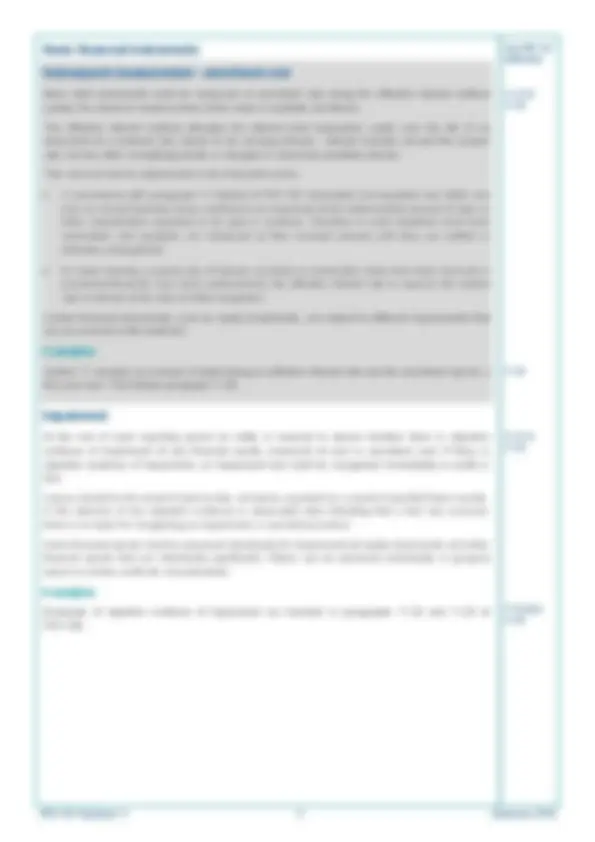

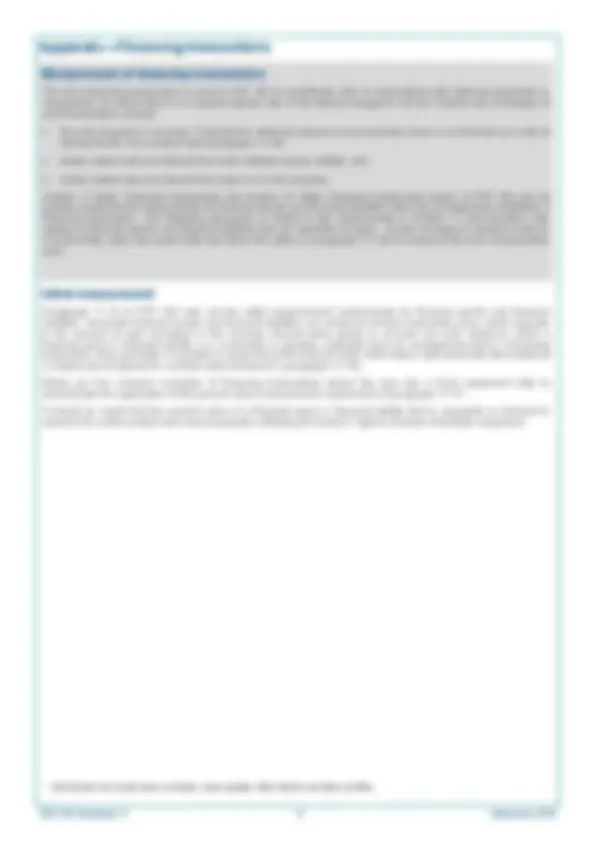
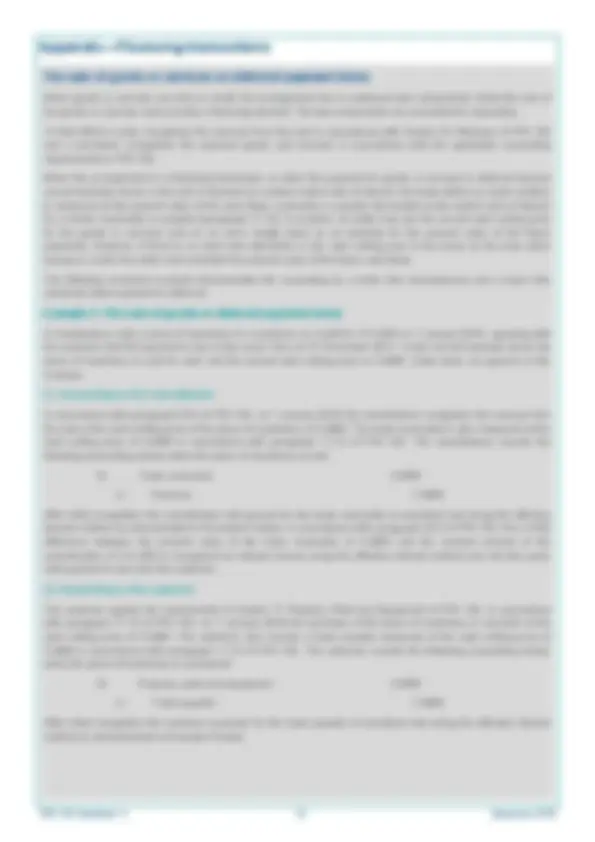
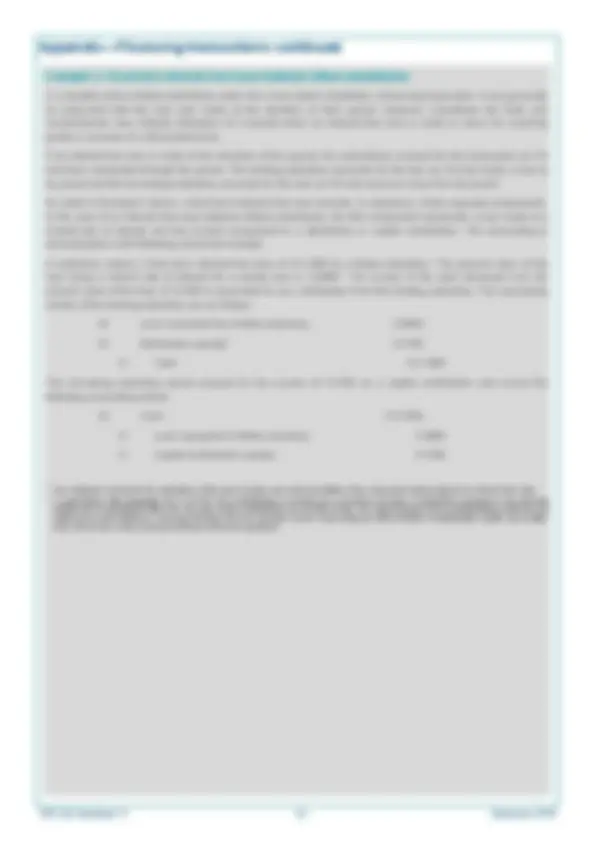
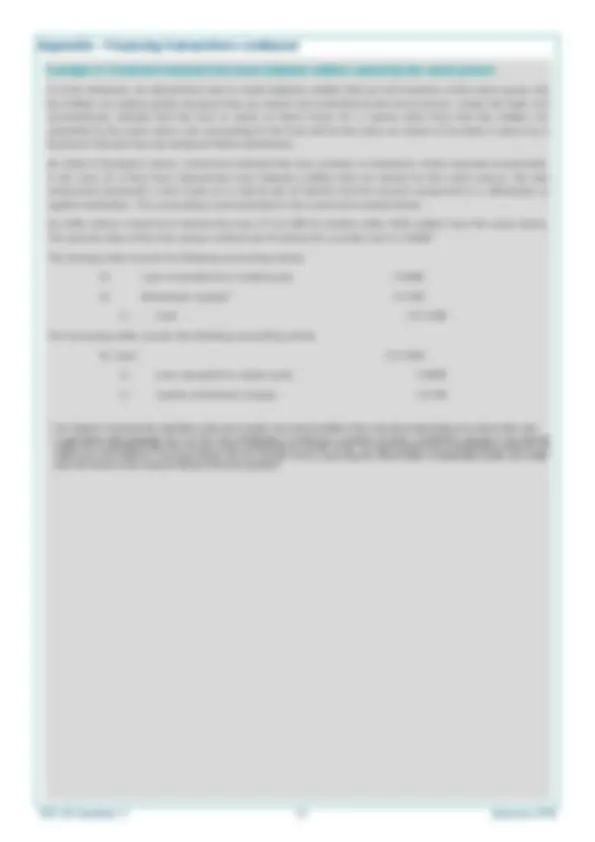
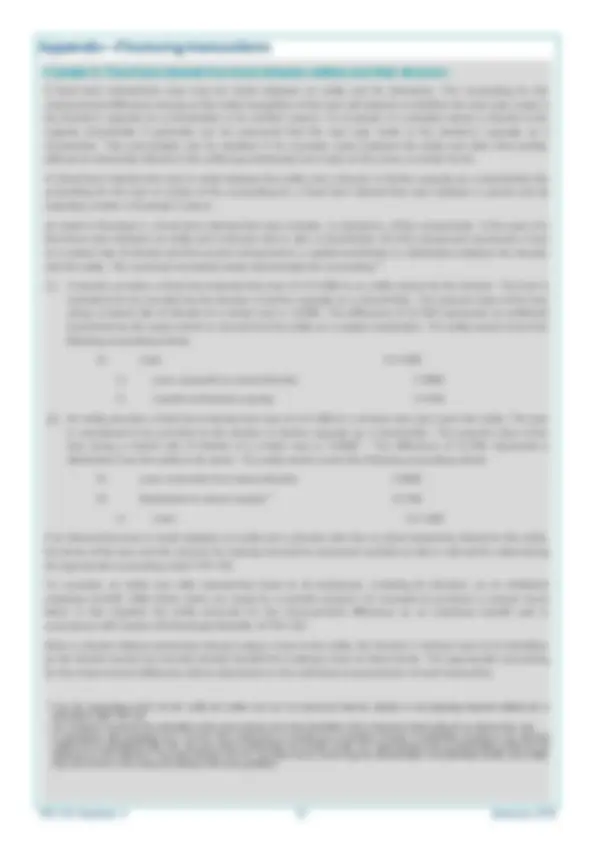


Study with the several resources on Docsity

Earn points by helping other students or get them with a premium plan


Prepare for your exams
Study with the several resources on Docsity

Earn points to download
Earn points by helping other students or get them with a premium plan
Community
Ask the community for help and clear up your study doubts
Discover the best universities in your country according to Docsity users
Free resources
Download our free guides on studying techniques, anxiety management strategies, and thesis advice from Docsity tutors
A summary of the key requirements of FRS 102 related to financial instruments, including accounting policy choices, classification, initial and subsequent measurement, and disclosure requirements. It covers various types of financial instruments, such as basic financial instruments, financing transactions, and financial instruments at fair value through profit or loss.
What you will learn
Typology: Lecture notes
1 / 17

This page cannot be seen from the preview
Don't miss anything!










FRS 102 significantly changed the accounting for financial instruments in comparison to the requirements applicable to most UK and Ireland entities prior to its introduction. Although the extent to which the changes affected individual entities depended on the financial instruments held, the implementation of the new requirements for financial instruments was reported to be one of the most challenging aspects of transition to FRS 102. FRS 102 sets out the requirements for financial instruments in two sections, Section 11 Basic Financial Instruments and Section 12 Other Financial Instruments Issues. Section 11 is relevant to all entities applying FRS 102, but Section 12 is only relevant to entities that have more complex financial instruments and transactions. However, Section 12 applies to derivatives, including forward foreign exchange contracts and interest rate swaps, that many entities, including smaller entities, may have. This factsheet has been prepared by FRC staff and provides a summary of the key requirements of FRS 102 in relation to financial instruments including the following:
For financial instruments, FRS 102 allows entities a choice between applying the recognition and measurement requirements of:
A financial instrument is a contract that gives rise to a financial asset of one entity and a financial liability or equity instrument of another entity. It includes cash, trade receivables and payables, equity investments, borrowings and derivatives. Some financial instruments are outside the scope of Sections 11 and 12, such as investments in subsidiaries, associates and joint ventures, and these are not considered in this factsheet. Key FRS 102 references 11.2, 12. 11.3, 11.5, 11.
Usually initial recognition will be at transaction price, adjusted for transaction costs. Financing transactions One of the exceptions to this relates to financing transactions. A financing transaction has taken place when payment is deferred beyond normal business terms, or has been financed at a rate of interest that is not a market rate. Therefore examples would include offering a buyer interest-free credit or providing an interest-free loan. Financing transactions shall be measured at the present value of the future payments discounted at a market rate of interest for a similar instrument, adjusted for transaction costs. This means it should be measured as if it were a market-rate loan. Directors’ loans As an exception to the usual requirements for financing transactions, a small entity that has received a loan that is not at a market rate of interest from a person who is within a director’s group of close family members, and that group includes at least one shareholder in the entity, may choose to measure that loan initially at transaction price. This only applies to small entities and only to loans to the entity. Public benefit entity concessionary loans As an exception to the usual requirements for financing transactions, a public benefit entity and other members of a public benefit entity group that make or receive public benefit entity concessionary loans, may account for such loans at the amount paid or received adjusted for interest and any impairment loss. Examples Section 11 includes six examples of initial measurement. These follow paragraph 11.13. Examples of accounting for financing transactions are set out in the appendix to this factsheet. _Key FRS 102 references
11.13A PBE11.1A, 11.13A, PBE34.87 to PBE34. 11._
Basic debt instruments shall be measured at amortised cost using the effective interest method (unless the choice to measure them at fair value is available and taken). The effective interest method allocates the interest (and transaction costs) over the life of an instrument at a constant rate, based on its carrying amount. Interest includes not just the coupon rate, but any other receipts/payments or changes in value that constitute interest. This need not lead to adjustments to the transaction price:
Section 11 includes an example of determining an effective interest rate and the amortised cost for a five-year loan. This follows paragraph 11.20.
At the end of each reporting period an entity is required to assess whether there is objective evidence of impairment of any financial assets measured at cost or amortised cost. If there is objective evidence of impairment, an impairment loss shall be recognised immediately in profit or loss. Losses should be the result of past events, not losses expected as a result of possible future events. In the absence of any objective evidence or observable data indicating that a loss has occurred, there is no basis for recognising an impairment, or bad debt provision. Some financial assets must be assessed individually for impairment (all equity instruments and other financial assets that are individually significant). Others can be assessed individually or grouped based on similar credit risk characteristics.
Examples of objective evidence of impairment are included in paragraphs 11.22 and 11.23 of FRS 102. _Key FRS 102 references 11.14 to
11.21 to
11.22 and 11._
Various disclosures are required about financial instruments. The following does not necessarily apply to a qualifying entity that takes advantage of reduced disclosures as set out in Section 1 Scope of FRS 102, nor to a small entity applying Section 1A Small Entities. Disclosure requirements include the significant accounting policies and measurement bases for financial instruments and the carrying amounts of financial instruments measured at fair value through profit or loss. Various items of income, expense, gains and losses must be disclosed including changes in fair value, interest income and expense, and impairment losses. Paragraph 11.42 contains a significant requirement: This is a principle-based disclosure requirement. Examples are given of possible disclosures for a debt instrument, such as interest rate, maturity, repayment schedule and any restrictions on the entity. However, entities will need to consider carefully what information is needed by users. As part of the triennial review of FRS 102, paragraph 11.42 was expanded to note that when the risks arising from financial instruments are particularly significant to the business (for example they are principal risks for the entity) additional disclosures may be required.
Company law sets out requirements about which financial instruments can be measured at fair value and includes related disclosure requirements. In the UK financial assets, and financial liabilities that are held as part of a trading portfolio or are derivatives are always permitted to be measured at fair value. In the UK, any other financial liabilities can be measured at fair value only when this is permitted by IFRS and provided certain disclosures required by IFRS are given. In the Republic of Ireland, all financial instruments can be measured at fair value when this is permitted by IFRS and provided certain disclosures required by IFRS are given. Therefore additional disclosures may be required more frequently in the Republic of Ireland as they apply to any financial instruments measured at fair value, including derivatives. The additional disclosure has been incorporated into Section 11 (as explained in paragraph A3.13). Some of the disclosures apply to all financial instruments, others are reflected in paragraph 11.48A.
Additional disclosure is required by financial institutions and retirement benefit plans. These are set out in separate sub-sections of Section 34 Specialised Activities. An entity shall disclose information that enables users of its financial statements to evaluate the significance of financial instruments for its financial position and performance ... Key FRS 102 references 11.40 to 11.48A 11.48B 11.48C
This applies to financial instruments that are within the scope of Section 12.
Usually a financial asset or a financial liability within the scope of Section 12 is recognised initially at fair value, which is normally transaction price. If a financial asset arises from a financing transaction, it is initially measured at the present value of the future payments discounted at a market rate of interest for a similar debt instrument (as determined at initial recognition) and adjusted for transaction costs.
Other financial instruments shall normally be measured at fair value, with the change in fair value recognised in profit or loss. There are some exceptions to this, such as in certain hedge accounting relationships and when the use of fair value would not be permitted by company law. The latter is expected to arise rarely.
In practice this means that any interest rate swaps or forward foreign exchange contracts will be measured at fair value at each reporting date, with the change in fair value being recognised in profit or loss, unless the entity chooses to apply hedge accounting. The contract rate agreed in a forward foreign exchange contract cannot be used to measure the hedged item as it was under SSAP 20 Foreign currency translation.
Hedge accounting is optional. A hedging relationship consists of a hedging instrument and a hedged item. Provided the qualifying conditions set out in paragraph 12.18 are met, hedge accounting may be applied. The effect of hedge accounting is to reduce the volatility in the profit and loss account.
The Appendix to Section 12 provides examples of hedge accounting. _Key FRS 102 references
12.8 to 12. 12.15 to 12.25A_
Appendix—Financing transactions
When goods or services are sold on credit, the arrangement has in substance two components, firstly the sale of the goods or services and secondly a financing element. The two components are accounted for separately. To that effect a seller recognises the revenue from the sale in accordance with Section 23 Revenue of FRS 102 and a purchaser recognises the acquired goods and services in accordance with the applicable accounting requirements in FRS 102. When the arrangement is a financing transaction, ie when the payment for goods or services is deferred beyond normal business terms or the sale is financed at a below market rate of interest, the trade debtor (or trade creditor) is measured at the present value of the cash flows receivable or payable discounted at the market rate of interest for a similar receivable or payable (paragraph 11.13). In practice, an entity may use the current cash selling price for the goods or services sold on an arm’s length basis as an estimate for the present value of the future payments. However, if there is no cash sale alternative or the cash selling price is the same as the price when buying on credit, the entity must calculate the present value of the future cash flows. The following numerical example demonstrates the accounting by a seller (the manufacturer) and a buyer (the customer) when payment is deferred.
A manufacturer sells a piece of machinery to a customer on credit for CU1,000 on 1 January 20X0, agreeing with the customer that full payment is due in two years’ time on 31 December 20X1. Under normal business terms the piece of machinery is sold for cash and the current cash selling price is CU900. Sales taxes are ignored in this example.
In accordance with paragraph 23.5 of FRS 102, on 1 January 20X0 the manufacturer recognises the revenue from the sale at the cash selling price of the piece of machinery of CU900. The trade receivable is also measured at the cash selling price of CU900 in accordance with paragraph 11.13 of FRS 102. The manufacturer records the following accounting entries when the piece of machinery is sold: Dr Trade receivable CU Cr Revenue CU After initial recognition the manufacturer will account for the trade receivable at amortised cost using the effective interest method as demonstrated in Example 6 below. In accordance with paragraph 23.5 of FRS 102, the CU difference between the present value of the trade receivable of CU900 and the nominal amount of the consideration of CU1,000 is recognised as interest income using the effective interest method over the two years until payment is due from the customer.
The customer applies the requirements of Section 17 Property, Plant and Equipment of FRS 102. In accordance with paragraph 17.13 of FRS 102, on 1 January 20X0 the purchase of the piece of machinery is recorded at the cash selling price of CU900. The customer also records a trade payable measured at the cash selling price of CU900 in accordance with paragraph 11.13 of FRS 102. The customer records the following accounting entries when the piece of machinery is purchased: Dr Property, plant and equipment CU Cr Trade payable CU After initial recognition the customer accounts for the trade payable at amortised cost using the effective interest method as demonstrated in Example 6 below.
Appendix—Financing transactions
A loan provided or received at no or a below market rate of interest constitutes a financing transaction. Paragraph 11.13 of FRS 102 requires that such a loan is measured at the present value of the future cash receipts or payments discounted at a market rate of interest of a similar financial asset or financial liability. The present value calculated in accordance with paragraph 11.13 reflects the value of a similar loan with a market rate of interest. For loans other than those repayable on demand, a difference arises between the amount of cash received or advanced and the present value of the loan. This difference reflects that the lender has made a loan at a lower than market rate of interest and thereby has provided an additional benefit to the borrower. FRS 102 does not set out specific accounting requirements for that difference. Where FRS 102 does not specifically address the accounting for a transaction, an entity applies judgement to determine the accounting treatment that meets the requirements of paragraph 10.4, ie an entity selects an accounting policy that results in relevant and reliable information. Paragraph 10.5 sets out the sources an entity should consider for that analysis. To determine the accounting treatment for the difference, an entity should assess the particular facts and circumstances of each arrangement. In that regard it is particularly important to establish the reasons a lender decided to make a loan at a non-market rate of interest. For example, a lender may make the loan because of an ownership interest in the borrower. If so, the lender is, in its capacity as the owner, effectively making an additional investment in the entity when making a loan at a below market rate of interest. In other instances, there may be related transactions to consider, for example the lender may be compensated by obtaining goods or services from the borrower at below market prices. When a loan is made at a non-market rate of interest and the lender and the borrower are related parties because one owns the other or the lender and borrower are owned by the same entity or person, the difference arising on initial recognition of the loan would generally be accounted for as a distribution or capital contribution. FRS 102 sets out accounting requirements for distributions. For the entity making a distribution it represents a decrease of economic benefits that results in a decrease in equity. A distribution is not an expense and is therefore recorded as a reduction of equity (paragraphs 2.23(b) and 22.17). It should be noted that in some cases a distribution may be recorded in the financial statements in accordance with FRS 102, although it may not be a distribution as a matter of law and vice versa. An entity that is subject to company law should consider whether the distribution recorded in the financial statements for reporting purposes is also a distribution as a matter of the law and, if so, should assess whether it has sufficient distributable profits to make the distribution. The entity receiving a distribution records it as income, since it represents an increase in economic benefits that results in an increase of equity that is not related to a capital contribution from an equity investor (paragraph 2.23(a) of FRS 102). Income is recorded in total comprehensive income, either in profit or loss or in other comprehensive income. Company law prohibits the inclusion of unrealised profits within profit or loss, except when an unrealised revaluation gain arises from the application of fair value accounting. If the distribution is considered a realised profit it is recorded in profit or loss, otherwise it is recorded in other comprehensive income. An entity that is a company should assess whether the distribution received is a realised profit within the meaning of company law. The determination of realised and distributable profits in accordance with company law is a complex area where accounting and legal requirements interface. This Education Note does not address company law issues that may be relevant in this regard. An entity may refer to Technical Release 02/17BL Guidance on realised and distributable profits under the Companies Act 2006 (Technical Release 02/17BL) issued by the Institute of Chartered Accountants in England and Wales and the Institute of Chartered Accounts of Scotland, or any successor document. An entity may also wish to take specialist legal advice on these matters. Capital contributions from equity investors do not meet the definition of income (see paragraph 2.23(a)). A capital contribution is therefore recorded by the receiving entity as an increase in equity. The entity making a capital contribution records it as an increase in its investment in the entity receiving the capital contribution.
Appendix—Financing transactions continued
In a situation where fellow subsidiaries enter into a loan which constitutes a financing transaction, it can generally be presumed that the loan was made at the direction of their parent. However, sometimes the facts and circumstances may indicate otherwise, for example when an interest-free loan is made in return for receiving goods or services at a discounted price. If an interest-free loan is made at the direction of the parent, the subsidiaries account for the transaction as if it had been conducted through the parent. The lending subsidiary accounts for the loan as if it had made a loan to its parent and the borrowing subsidiary accounts for the loan as if it had received a loan from its parent. As noted in Example 2 above, a fixed term interest-free loan consists, in substance, of two separate components. In the case of an interest-free loan between fellow subsidiaries, the first component represents a loan made at a market-rate of interest and the second component is a distribution or capital contribution. The accounting is demonstrated in the following numerical example. A subsidiary makes a fixed term interest-free loan of CU1,000 to a fellow subsidiary. The present value of the loan using a market rate of interest for a similar loan is CU900^6. The excess of the cash advanced over the present value of the loan of CU100 is accounted for as a distribution from the lending subsidiary. The accounting entries of the lending subsidiary are as follows: Dr Loan receivable from fellow subsidiary CU Dr Distribution (equity)^7 CU Cr Cash CU1, The borrowing subsidiary would account for the excess of CU100 as a capital contribution and record the following accounting entries: Dr Cash CU1, Cr Loan repayable to fellow subsidiary CU Cr Capital contribution (equity) CU (^6) See Example 6 below for the calculation of the present value and a demonstration of the subsequent accounting for an interest-free loan. (^7) In accordance with paragraph 22.17 of FRS 102 a distribution is recorded as a reduction of equity. A distribution recorded in the financial statements in accordance with FRS 102 may not be a distribution as a matter of law. The legal requirements on distributable profits are not addressed in this factsheet. Technical Release 02/17BL considers issues concerning the determination of distributable profits and entities may refer to this or any successor document for more guidance.
In some instances, an interest-free loan is made between entities that are not members of the same group, but the entities are related parties because they are owned and controlled by the same person. Unless the facts and circumstances indicate that the loan is made on these terms for a reason other than that the entities are controlled by the same owner, the accounting for the loan will be the same as shown in Example 3 above for a fixed term interest-free loan between fellow subsidiaries. As noted in Example 2 above, a fixed term interest-free loan consists, in substance, of two separate components. In the case of a fixed term interest-free loan between entities that are owned by the same person, the first component represents a loan made at a market-rate of interest and the second component is a distribution or capital contribution. The accounting is demonstrated in the numerical example below. An entity makes a fixed term interest-free loan of CU1,000 to another entity. Both entities have the same owner. The present value of the loan using a market rate of interest for a similar loan is CU900^8. The lending entity records the following accounting entries: Dr Loan receivable from related party CU Dr Distribution (equity)^9 CU Cr Cash CU1, The borrowing entity records the following accounting entries: Dr Cash CU1, Cr Loan repayable to related party CU Cr Capital contribution (equity) CU (^8) See Example 6 below for the calculation of the present value and a demonstration of the subsequent accounting for an interest-free loan. (^9) In accordance with paragraph 22.17 of FRS 102 a distribution is recorded as a reduction of equity. A distribution recorded in the financial statements in accordance with FRS 102 may not be a distribution as a matter of law. The legal requirements on distributable profits are not addressed in this factsheet. Technical Release 02/17BL considers issues concerning the determination of distributable profits and entities may refer to this or any successor document for more guidance.
Appendix—Financing transactions
Basic financial assets and financial liabilities are generally measured at amortised cost using the effective interest method (paragraph 11.14(a) of FRS 102). This requirement applies regardless of whether the financial asset or financial liability results from an arrangement that constitutes a financing transaction or not. The effective interest rate is determined in accordance with the requirements of paragraphs 11.16 to 11.20 of FRS 102. Assuming that the original effective interest rate as determined at the time of the initial recognition of the loan is a fixed rate of interest, the rate is not updated for subsequent changes to the market rate of interest. The following numerical example demonstrates the subsequent accounting for an int e rest-free loan.
On 1 January 20X1 a subsidiary obtains an interest-free loan of CU1,000 from its parent. The loan is repayable in full on 31 December 20X2. The market rate of interest for similar loans is 5.4 per cent per annum. The net present value of the loan is CU900^13 (1,000/1.054^2 =900). The amortised cost of the loan as at 31 December 20X and 20X2 is as follows: On 1 January 20X1 the parent and the subsidiary would record the accounting entries set out in Example 2 above when a parent makes an interest-free loan to its subsidiary. As described in Example 2, at initial recognition the interest-free loan is accounted for as a loan at a market-rate of interest and a capital contribution or distribution. After initial recognition the interest-free loan is treated for accounting purposes as if it was a loan at a market rate of interest with capital and interest payable at the end of the term of the loan. Interest is accounted for applying the effective interest method. The entity receiving interest (in this example the parent) records it as income. Income is recorded in total comprehensive income, either in profit or loss or in other comprehensive income. Company law prohibits the inclusion of unrealised profits within profit or loss, except for an unrealised revaluation gain arising from the application of fair value accounting. If the interest income is considered a realised profit it is recorded in profit or loss, otherwise it is recorded in other comprehensive income. An entity that is a company should assess whether the interest income is a realised profit within the meaning of company law. The determination of realised profits in accordance with company law is a complex area where accounting and legal requirements interface. This factsheet does not address company law issues that may be relevant in this regard. An entity may refer to Technical Release 02/17BL, or any successor document. An entity may also wish to take specialist legal advice. The entity paying interest (in this example the subsidiary) records it as an expense in profit or loss. (^13) 900 is a rounded figure. Year Carrying amount at 1 January CU Interest accrued (5.4%) CU Cash flow CU Carrying amount at 31 December CU 20X1 900 49 - 949 20X2 949 51 (1,000) -
(^14) Company law requires that only profits realised at the reporting date are included in profit or loss. For the purpose of this example it is assumed that the interest income is a realised profit. The legal requirements on realised profits are not addressed in this factsheet. Technical Release 02/17BL considers issues concerning the determination of realised profits and entities may refer to this or any successor document for more guidance.